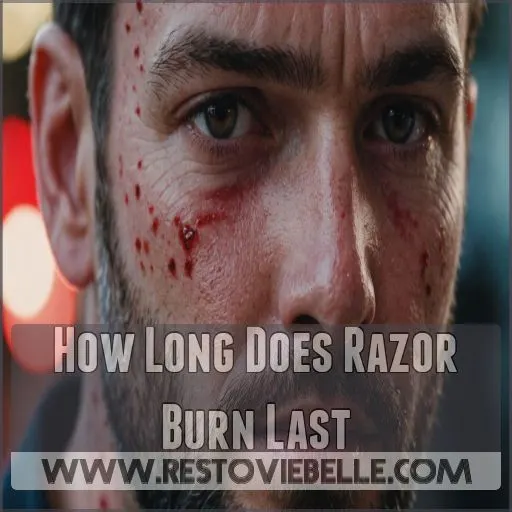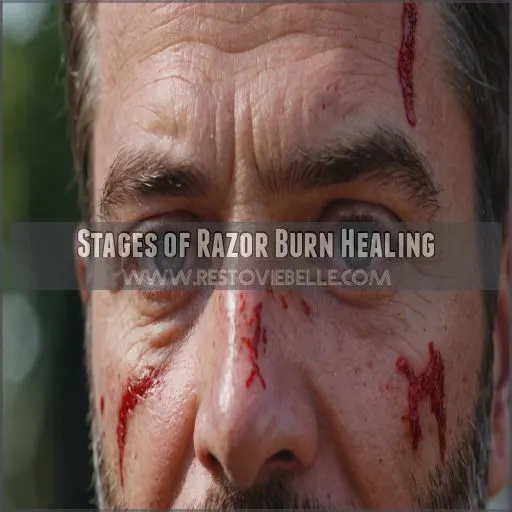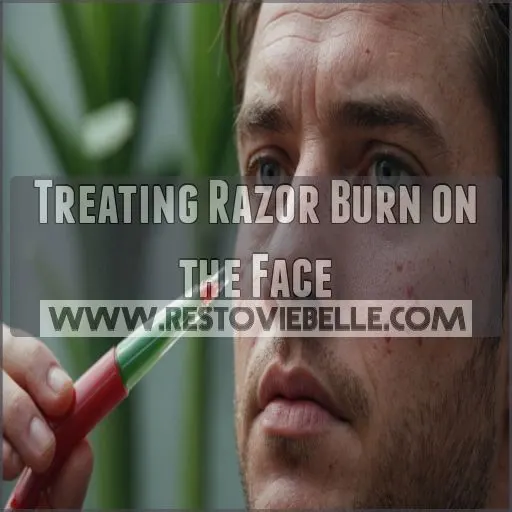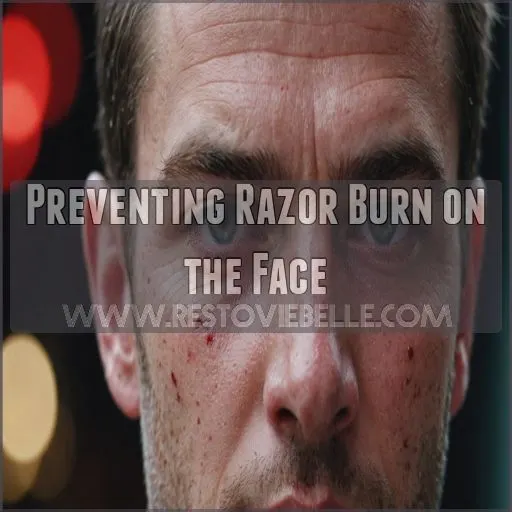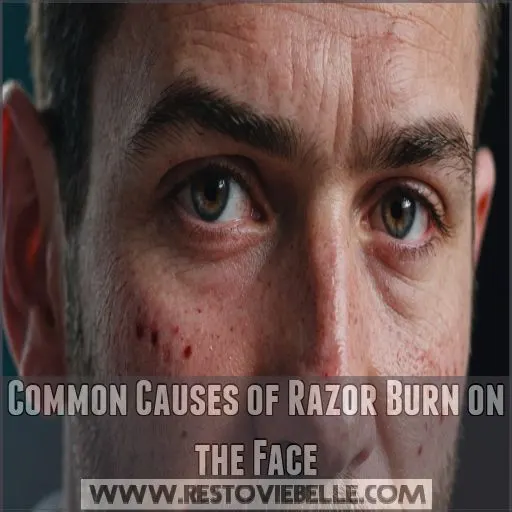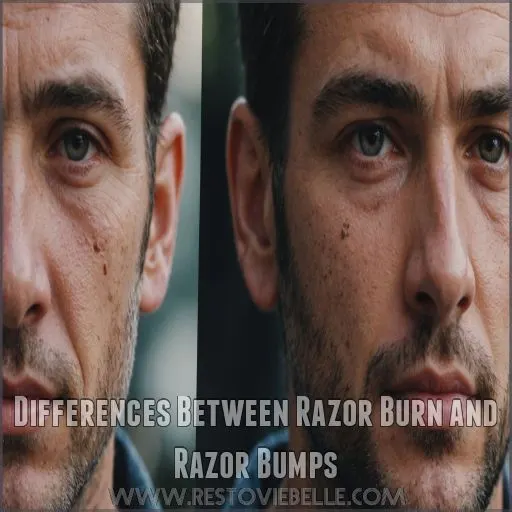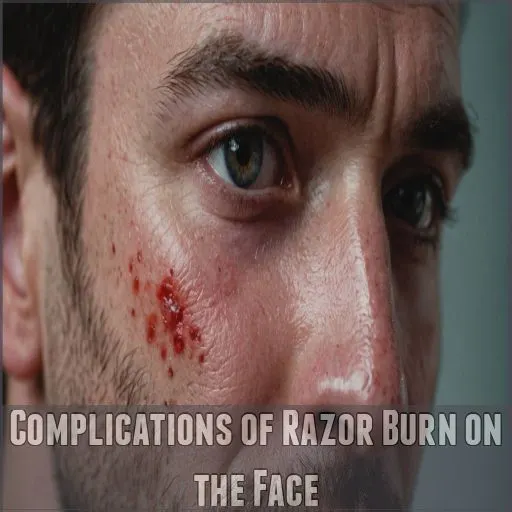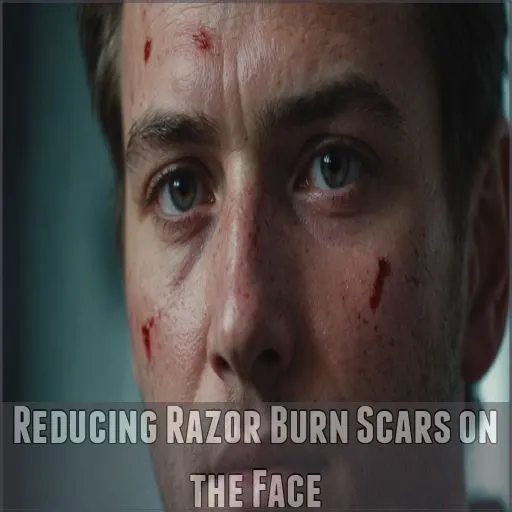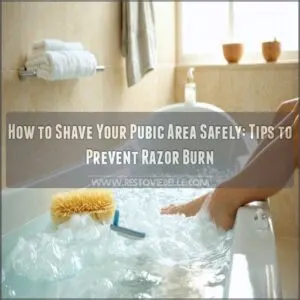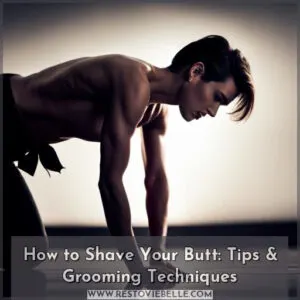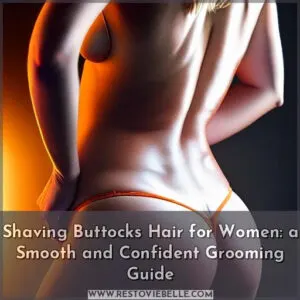This site is supported by our readers. We may earn a commission, at no cost to you, if you purchase through links.
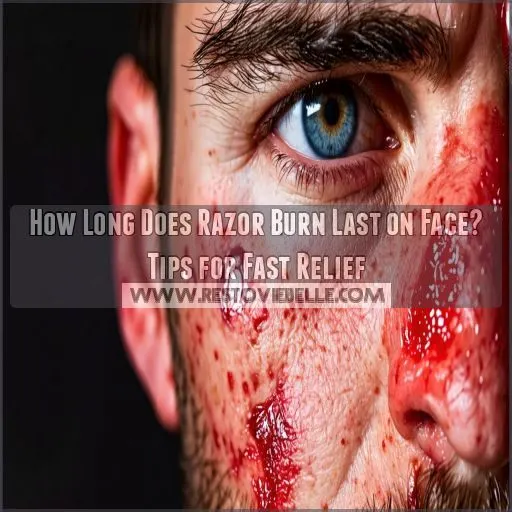
Factors like your shaving technique, skin type, and even aftershave routine can play a part in how quickly you bounce back.
For a speedy recovery, think cold compresses, soothing aloe vera, and witch hazel to tackle the irritation.
Want to sidestep razor burn hassles next time? There’s more to that story, packed with tried-and-true tricks to keep your skin smooth and burn-free, such as using a hydrating shave gel
.
Table Of Contents
- Key Takeaways
- How Long Does Razor Burn Last
- Stages of Razor Burn Healing
- Treating Razor Burn on the Face
- Preventing Razor Burn on the Face
- Common Causes of Razor Burn on the Face
- Differences Between Razor Burn and Razor Bumps
- Complications of Razor Burn on the Face
- Reducing Razor Burn Scars on the Face
- Frequently Asked Questions (FAQs)
- How long does Razor Burn Last after shaving?
- How long does a sunburn last?
- How long does razor burn take to heal?
- Does razor burn go away on its own?
- How do you get rid of razor burn on your face fast?
- How long does razor burn on face last?
- What does razor burn look like on face?
- How do you get rid of razor burn scars on your face?
- Can razor burn cause permanent skin damage?
- Are certain razors better for sensitive skin?
- Does diet affect the severity of razor burn?
- Can shaving less often help prevent razor burn?
- How do weather conditions influence razor burn?
- Conclusion
Key Takeaways
- Razor burn on your face usually plays the "here today, gone in a few days" game, unless you have sensitive skin, which might take up to a week to recover. Tending to it with cold compresses and soothing aloe vera can help you kick it out faster.
- Your recovery speed really depends on how you shave, your skin type, and your aftershave rituals. Think of it like prepping a dish – the right ingredients can make it gourmet or let it fester in the oven.
- Prevention is your best bet: prep your skin before, shave with sharp razors, and don’t rush through it like a cheetah. Take it slow, and maybe even groove to some tunes.
- Differentiate razor burn from bumps – burns are quick to show their red, itchy faces post-shave, while bumps might take a little longer to rear their bumpy heads and require some hair-poking intervention.
How Long Does Razor Burn Last
Razor burn on your face is the unwelcome aftermath of shaving, leaving you red and itchy for days.
Typically, it fades within a few days to a week, but knowing how to speed up the process can save you some trouble.
Factors Influencing Healing Time
Healing time for razor burn varies.
It depends on:
- Skin type: Sensitive skin can take longer to heal.
- Shaving technique: Going against the grain increases irritation.
- Aftershave use: Soothing products aid faster recovery.
- Medication: Over-the-counter creams can reduce inflammation.
- Hydration: Well-hydrated skin heals quicker.
Mind these factors, and you’ll be razor burn-free in no time!
Average Healing Time for Razor Burn
Razor burn often lasts two to three days, making it surprisingly short-lived, especially with proper care. Your skin type and healing speed can alter this timeline.
Here’s a quick table:
| Skin Type | Expected Healing Time |
|---|---|
| Sensitive | Up to a week |
| Normal | 2-3 days |
| Oily | 2-4 days |
| Dry | 3-5 days |
Remember, razor burn is just a bump in the road!
How to Speed Up the Healing Process
While razor burn typically clears up quickly, you can speed up the healing process.
Try using home remedies like a cold compress and aloe vera, which soothe irritation and strengthen your skin barrier.
Natural products like tea tree oil and apple cider vinegar can reduce inflammation.
To maintain overall good skin health, remember to hydrate properly, manage stress, and maintain a healthy diet.
Stages of Razor Burn Healing
Wondering how long that pesky razor burn will last on your face? Don’t worry, it usually goes through a few predictable stages before fully healing.
Stage 1: Immediate Reaction
You’ve just finished shaving, and soon enough, you notice that skin redness and a burning sensation kick in.
This immediate reaction can make you feel like your face is on fire, especially if you’ve dry shaved or used a less-than-sharp razor.
Skin tightness adds to the discomfort, and itching can be frustrating, signaling the onset of razor burn and a generally uncomfortable feeling of your face being on fire.
Stage 2: Peak Irritation
As irritation increases, you enter Stage 2: Peak Irritation. The skin feels like it’s on fire, itching and red from shaving incorrectly, often due to using dull blades or improper shaving techniques.
Understanding this stage helps shorten the Duration and Severity of razor burn. Using a sharp razor blade, like those from best safety razor blades, and shaving in the direction of hair growth can help alleviate this
.
- Your face might feel like a cactus.
- That rash seems to glow in the dark.
- You’d rather skip the mirror.
- Imagining relief calms your mind.
Stage 3: Healing Begins
After peak irritation, relief is finally on the horizon. Healing begins as redness diminishes and the skin starts repairing itself.
Consider using soothing techniques like aloe vera or oatmeal baths for comfort.
For a quick overview, check the table below for effective remedies:
| Soothing Techniques | Home Remedies | Scar Prevention |
|---|---|---|
| Cool Compress | Aloe Vera | Moisturizer |
| Witch Hazel | Coconut Oil | Vitamin E Lotion |
| Hydrocortisone | Tea Tree Oil Gel | Gentle Cleanser |
| Lightweight Lotion | Oatmeal Bath | Avoiding Scratching |
| Over-the-counter Cream | Apple Cider Vinegar | Avoid Sun Exposure |
Stage 4: Full Recovery
Reaching full recovery feels like crossing a finish line.
Your skin should be smooth and irritation-free, but don’t toss good habits yet!
Keep a razor burn prevention routine by using quality shaving products, shaving with the grain, and taking skin care seriously after recovery.
This helps prevent scarring and makes sure long-term effects remain just a memory, ensuring that full recovery from razor burn has been achieved.
Treating Razor Burn on the Face
Treating razor burn on your face might seem tricky, but a few straightforward remedies can help calm your skin.
Applying a cold compress, aloe vera, and witch hazel, or using hydrocortisone cream, can provide much-needed relief from irritation and redness.
Applying a Cold Compress
Feeling that sting after shaving? A cold compress offers quick relief for razor bumps and pseudofolliculitis barbae.
Gently press a cold, damp cloth on the irritated skin for 20 minutes to reduce inflammation and cool the burn. Unlike ice, a compress won’t freeze your skin.
Apply as often as needed, savoring the comfort and control it brings.
Using Aloe Vera to Soothe Irritation
Dealing with razor burn? Reach for aloe vera! This soothing plant can help calm irritated skin and provide much-needed relief.
Gently apply a thin layer of pure aloe vera gel to the affected area. Its cooling properties will soothe the burn and promote healing.
For best results, use aloe vera daily until your skin fully recovers.
Applying Witch Hazel for Inflammation
Just as aloe vera soothes, witch hazel effectively tackles inflammation from reducing razor bumps
. It’s like giving your face a calm spa day in a bottle.
Try these steps:
- Clean your face with cold water.
- Dab witch hazel gently onto affected areas.
- Allow it to air dry.
- Enjoy the relief, even compared to aloe vera’s comforting embrace.
Using Hydrocortisone Cream for Redness
After soothing inflammation with witch hazel, grab hydrocortisone cream for that lingering redness.
It’s a corticosteroid that reduces swelling and itching, providing quick relief for razor burn on your face, according to the Cleveland Clinic.
Be mindful of side effects like irritation or dryness. Stick to top brands like Cortizone-10, and consider growing a beard as a fun alternative.
Preventing Razor Burn on the Face
If you want to keep razor burn at bay, start by preparing your skin before shaving and using a sharp razor to reduce irritation.
Shave with the grain to minimize ingrown hairs and enjoy smoother skin without the pesky burn.
Preparing Your Skin Before Shaving
Before shaving, preparing your skin sets the stage for a smooth experience. Start by exfoliating to remove dead skin, allowing the razor to glide effortlessly. Use warm water to hydrate and soften facial hair, reducing irritation.
Experiment with "riding the cap" for a milder shave, and apply a pre-shave oil to reduce irritation, eliminate razor burn, and soften stubborn hairs Mastering the Razor Angle.
Avoid a dirty razor to keep skin calm and happy.
Using a Sharp Razor to Reduce Irritation
With a sharp razor in hand, avoid the irritation dance. Choosing the right razor blade type, like a safety razor or disposable razor, helps you get a precise cut and reduces inflammation. Know the sharpness impact and watch for dull razor signs. Razor maintenance is key—keep it clean, listen to the Cleveland Clinic, and say goodbye to razor burn woes.
- Protect your skin
- Enhance your confidence
- Enjoy smoother shaves
- Bid farewell to discomfort
Shaving With the Grain to Minimize Ingrown Hairs
Understanding your hair growth patterns is really important to preventing razor burn, especially when using a razor for black men best razor for black men
.
Shave with the grain, or in the direction your hair grows, to reduce irritation and minimize ingrown hairs.
Begin your shave with proper skin prep, like warming your face with water, and use a gentle razor technique. Avoid excessive pressure—let the razor do its magic (Source).
Common Causes of Razor Burn on the Face
Razor burn on the face can be caused by shaving too quickly, applying too much pressure, or using an old, dull razor.
It can also happen if you don’t properly prepare your skin before shaving.
Shaving Too Quickly or With Too Much Pressure
Rushing through your shave or applying too much pressure can lead to razor burn, leaving your skin irritated and red.
- Correct Shaving Techniques: Move slowly, avoid pressing the razor.
- Skin Sensitivity Awareness: Adjust pressure based on sensitivity.
- Proper Razor Blade Quality: A sharp blade prevents tugging.
- Gentle Touch Practice: Let the razor glide smoothly.
Reduce burn and discomfort with these tips!
Shaving Over Dry Skin
Moving from too much pressure, shaving over dry skin can be a culprit for razor burn.
Imagine sliding a sled over gravel—uncomfortable, right? The same goes for your face without proper moisture.
Shaving tips: hydrate your skin with a good moisturizer before shaving, focus on skin prep, and choose the right razor to keep irritation at bay.
Using an Old or Dull Razor
An old or dull razor can really throw a wrench in your shaving routine.
Instead of cleanly slicing hairs, it tugs at them, leading to razor burn and irritation.
Replace dull razors before they wear out to avoid discomfort.
A sharp razor reduces risks like ingrown hairs and uneven cuts, making your shave safer and smoother (Source).
Not Preparing Your Skin Before Shaving
Switching from an old blade to a fresh one is smart, but prepping your skin is equally important.
Start by softening your beard with warm water. Use exfoliation tips to peel away dry skin, ensuring a clean shave.
Aftershave balms with cooling ingredients can also help soothe the skin, reducing inflammation and itching associated with shaving techniques that cause irritation.
Apply a pre-shave oil for extra glide, which can help prevent razor burn, a common skin irritation caused by shaving. Finish with a quality shaving cream. This routine prevents razor burn effectively.
- Warm water
- Exfoliation tips
- Dry skin removal
- Pre-shave oil
- Shaving cream
Differences Between Razor Burn and Razor Bumps
When dealing with razor burn or razor bumps, it’s important to know which itchy enemy you’re facing.
Razor burn shows up as a red rash soon after shaving, while those pesky razor bumps appear later and occur when hair grows back into the skin.
Understanding Razor Burn
Imagine this: you’ve just finished shaving, and suddenly, your skin feels like it’s been set on fire. Razor burn, those pesky red patches, result from improper shaving techniques, like going against the grain or using a dull blade.
It’s a common skin irritation caused by shaving, and it often appears as a red, itchy, burning blanket across the skin. It varies by skin type and typically heals in days with soothing home remedies for razor burn, ensuring comfort in no time
.
You should be able to tell the difference between razor burn and razor bumps, a condition that causes ingrown hairs and can be more painful and inflamed.
Understanding Razor Bumps
Razor bumps are a common skin condition caused by shaving, which can often lead to irritating clogged pores
.
They appear as small, red bumps and are often the result of ingrown hairs.
Unlike razor burn, which causes general irritation, razor bumps are more localized and can be treated by avoiding shaving the affected area until the bumps subside.
How to Tell the Difference
You’ve grasped the basics, now let’s explore how to tell razor burn from bumps. Razor burn usually appears as red streaks, while razor bumps, like ingrown hairs, look like small pimples.
Here’s your quick checklist:
- Burn: Redness and irritation
- Bumps: Raised, possibly with a hair
- Cause: Different shaving techniques result in each.
Complications of Razor Burn on the Face
When razor burn strikes your face, it can lead to more than just temporary discomfort.
If not properly managed, you might face complications like ingrown hairs, infections, or even long-lasting scars.
That could overstretch your shaving routine into a minor facial saga.
Ingrown Hairs and Scarring
Preventing ingrown hairs is key to avoiding scarring after razor burn.
To minimize scarring risk, gently exfoliate your skin and avoid picking at ingrown hairs. Keeping the skin clean and moisturized can help.
If scarring does occur, consider scarring treatment options like topical creams or professional advice from a dermatologist.
Remember, patience is your best friend in healing.
Skin Infections and Abscesses
Ingrown hairs can lead to infections and even abscesses on your face, causing discomfort. To tackle this, focus on infection prevention by keeping your skin clean.
If an abscess forms, consider these steps:
- Antibiotics use: Can be necessary for bacterial infections.
- Pus drainage: A procedure to alleviate pressure.
- Home remedies: Warm compresses to soothe the area.
Seek medical advice when necessary.
Hyper-Pigmentation and Dark Spots
Razor burn isn’t just about uncomfortable redness; it can lead to hyper-pigmentation and pesky dark spots.
This happens when your skin reacts by producing excess melanin, the pigment responsible for skin color, as a protective response to irritation.
To prevent these spots, focus on gentle shaving techniques, proper skin care, and keeping your skin moisturized.
Remember, prevention is key .
Permanent Scarring and Keloid Formation
Though hyper-pigmentation might fade, scarring after shaving can become a long-term hitch.
Keloids, those tough little rascals, develop when your body’s collagen production goes into overdrive, creating thick, raised scars .
Minimize scar risk by consulting a dermatologist early on and exploring scar treatment options like pressure therapy or silicone gel sheets.
Prevention is your best buddy here!
Reducing Razor Burn Scars on the Face
Don’t let razor burn scars get you down – there are plenty of ways to reduce their appearance.
From using topical creams and ointments to applying soothing aloe vera gel, you can get your skin back to its smooth, healthy self in no time.
Using Topical Creams and Ointments
Topical creams can be your best friend in reducing razor burn scars.
Look for products with ingredients like silicone or vitamin E, known for scar reduction.
Before diving in, check side effects and follow safety tips.
Choose the best products to suit your skin needs; after all, who wants an itchy face when you could have a smooth one?
Applying Aloe Vera Gel to Reduce Inflammation
Ever feel like your face is hosting a circus after shaving?
For a natural remedy, grab some aloe vera gel. Its anti-inflammatory properties calm skin irritation by reducing redness and swelling.
Apply the gel gently; it’s like giving your face a soothing, cool hug. Effortlessly, aloe vera benefits your skin, turning chaos into calmness (Source).
Considering Professional Treatments for Scarring
Aloe vera’s soothing touch might help inflammation, but stubborn razor burn scars could call for professional treatments.
Consider scar treatment options like laser resurfacing, dermabrasion, or microneedling. These methods can diminish scars and rejuvenate skin by promoting collagen production.
Chemical peels offer another route, removing damaged skin layers to reveal smoother skin beneath.
Taking control of your skincare routine never felt better!
Frequently Asked Questions (FAQs)
How long does Razor Burn Last after shaving?
Razor burn usually lasts anywhere from a few hours to a couple of days.
Your skin will heal faster if you avoid shaving the affected area, keep it moisturized, and use soothing treatments like aloe vera or cool compresses.
How long does a sunburn last?
A sunburn may have you feeling like you’re on fire, but don’t worry – the pain and redness will subside in 3-5 days for mild burns, or up to 2 weeks for severe cases.
How long does razor burn take to heal?
Razor burn typically heals within a few days, but it can take up to 3 weeks to completely disappear.
Applying topical treatments, keeping the skin moisturized, and avoiding shaving can help speed up the healing process.
Does razor burn go away on its own?
Imagine your skin dancing happily again!
Razor burn typically vanishes on its own in a few days.
Rest your razor, apply cool compresses, and moisturize.
If symptoms persist, consult a healthcare provider for guidance.
How do you get rid of razor burn on your face fast?
To quickly soothe razor burn on your face, apply cold compresses.
Then moisturize with aloe vera or a fragrance-free cream.
Consider using diluted tea tree oil for its antimicrobial properties.
Let your skin heal before shaving again.
How long does razor burn on face last?
Feeling an irritating burn on your face? You’re not alone.
It usually lasts a few hours to a couple of days.
To speed healing, avoid shaving the affected area and try soothing treatments like aloe vera.
What does razor burn look like on face?
Razor burn on your face looks like a blotchy, red rash with small bumps.
It’s caused by irritation from shaving and can feel tender or itchy.
You’ll likely see it soon after shaving.
How do you get rid of razor burn scars on your face?
Did you know 15% of people experience scars from razor burns?
To banish them, consider using products like glycolic acid to gently exfoliate, promoting healing and regeneration.
Consult a dermatologist for treatments like laser therapy if needed.
Can razor burn cause permanent skin damage?
While razor burn itself doesn’t typically cause permanent skin damage, neglecting it can lead to complications like infection or scarring.
Proper care and treatment can prevent these issues, keeping your skin healthy and irritation-free .
Are certain razors better for sensitive skin?
Selecting the right razor can feel like finding a needle in a haystack.
For sensitive skin, opt for single-blade or straight razors.
They minimize irritation, decreasing the risk of razor bumps and ingrown hairs.
Does diet affect the severity of razor burn?
Diet doesn’t directly cause razor burn, but healthy skin benefits from good nutrition.
Antioxidant-rich foods, like fruits and vegetables, can promote skin health, potentially reducing irritation risk.
Stay hydrated and maintain a balanced diet for better results, and prioritize antioxidant-rich foods.
Can shaving less often help prevent razor burn?
Skipping a shave or two isn’t just laziness; it can actually help your skin heal and reduce razor burn.
Giving your skin a breather allows it to recover, minimizing irritation and discomfort from frequent shaving.
How do weather conditions influence razor burn?
Cold, dry weather intensifies razor burn.
Your skin becomes dry and sensitive, especially in winter, making it more prone to irritation.
Moisturizing is essential to combat these effects and protect your skin from winter’s harshness, which is winter’s harshness .
Conclusion
Shake off that razor burn like a dog after a bath – with the right know-how, you can get your face back to smooth sailing in no time.
From soothing cold compresses to skin-nourishing aloe vera, the keys to a speedy recovery from razor burn on your face are at your fingertips.
Follow these tips, and you’ll be back to your close-shaven best, with a face that’s free of razor burn, before you know it, and ready for speedy recovery.

